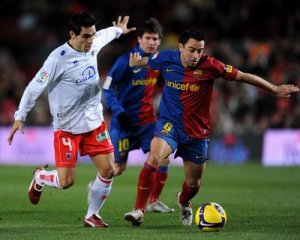By Jimmy Shan
Barcelona are renowned for playing mesmerising, tantalising football. I have no doubt that they are and have been for a number of years the in team in terms of their attacking brand of football and their possession dominance. Every aspiring youth coach will dissect the way they play, the individual brilliance of Xavi, Iniesta, Messi and co…. but is their dominance purely down to what they do with the ball?
The answer is no… Pep Guardiola has publicly stated that he does not rate his team without the ball, when you think deeper how many naturally defensive minded players does he have at his disposal?
The biggest challenge Pep Guardiola faced was to improve the work rate of his players, there mentality without the ball and the introduction of the 6 second rule. This was the tactical masterstroke that put the final piece in the Barcelona DNA jigsaw.
If Barcelona weaknesses were to be without the ball what better tactics to assist their ability to retain the ball for long periods of time than to implement a strategy to regain the ball back as early as possible in transition.
This in turn saw Guardiola implementing the 6 second rule, demanding a regain of possession within 6 seconds. In training Guardiola religiously times how long a team is without the ball, the 6 second count down encourages the team to regain the ball quickly.
Barcelona’s in possession game is based around short fast passes and interchanges which lends itself nicely to the 6 second rule due to the team’s natural compact shape.
The 6 second rule is based around quick transition, the ability to smother the ball and act positively to react to attempt to crowd out spaces and passing options. The nearest 2-3 players are key to the success of this process, an ability to press aggressively with no fear, with the knowledge that back up is close to hand. These players press with an intensity and a predictably which enables supporting players to take up positions that are relevant to this. With 2-3 players affecting the ball the remaining 7-8 ensure compactness and often will see all players well with inside an area the size of quarter of a pitch. Key roles for these players will be to position themselves into dare positions, tempting a pass to enter their zone so that they can press and harass. Players furthest from the ball will ensure there is a balance to the team compactness / shape, this is of paramount importance.
Often pressing this aggressively (harassing) will see / force an opposition into making mistakes, forcing passes, making hurried decisions, miss placing passes etc. These mistakes will often see the return of possession to Barcelona. In situations where there is a regain of the ball, the tactical thought process seems to be geared around stealing possession and moving it on quickly. Of course the ability to manage the ball in a tight area and have technical excellence is a big benefactor in playing / utilising this defensive strategy.
The Barcelona transition master class is not all about the 6 second rule, if the team fail to win the ball back in this time frame they will fall back into a very English like 4 4 2. Once this shape has been established from this base the pressing phase can restart – typically responding to traditional pressing triggers (square pass, long travelling pass etc.) Again the ability to steal it and move it on quickly is a key factor and often executed with such elegance, speed and finesse.
So the next time you watch a Barcelona game, be sure to be wowed by the vision of Xavi the dribbling skills of Messi. Don’t forget to keep an eye out for the brilliant way they regain possession so quickly.
Jimmy Shan: West Bromwich Albion FC U18 Head Coach



Hi Jimmy. You are absolutely correct in focusing on Barcelona’s defensive qualities. As you say, they are unequalled in their ability to regain the ball quickly. Whilst this early ball re-possession is taking place, positional rotation takes place to cover any gaps that might open up in their defence.
An important point that must be highlighted is that Barcelona have produced or acquired players who are able to defend or attack with quality and understanding. As we have ‘preached’ over many years, there is no substitute for individual playing ability!
Hi John. You are dead right Barcelona have a great ability to ‘shut’ the door when taking up covering positions. Almost a No way out policy. The biggest thing for me is the no fear mentality when pressing as an individual, often the first pressing player will get it wrong – beaten by a touch / pass – line of approach not quite right, yet because the team all by into the 6 second rule and pressing approach the next space / passing lane will be blocked.
You mention there is no substitute for individual playing ability – I could not agree more, producing OUTSTANDING ball managers and decision makers has to be the main focus in any youth development phase and program. The biggest problem in this country is FEAR – not enforced from our players but sadly installed via coaches.
I think that Barcelona have progressed the ‘pressing’ style of Holland in the seventies and AC Milan in the eighties. Their short passing, possession- based ‘tiki taki’ game goes hand-in-hand with the those crucial moments when the opposition have gained possession. Xavi, Iniesta,Messi, Busquets and co play in small groups, always close together,so when possession changes hands they do not have far to run, rarely more than 10 metres, in order to get the ball back by pressing. This contrasts with the English style of longer passes which therefore involves longer distances to run, in order to press, when possession has been lost.
We spend too much time ‘chasing the game’ because so much of our game is built, from a young age, around chasing the ball. As Jimmy says in his interesting article, Guardiola has often been critical of Barca’s defensive shape when the opposition attack. In England many coaches work very hard on shape. The defensive shape of many of our teams is probabaly superior to that of Barcelona, but their pressing, within the ‘6 second rule’, around the area of the ball, makes them much more effective.
I think that getting children from a young age, to appreciate how and where to find space, is vital. I feel that this is one of the strengths of the Premier Skills, Practice-Play methodology. Last Sunday, at the Level 1 Course at Welwyn Garden City, excellently taken by Dave Williams, this was a message really taken on board by all the attendee coaches, who were mainly from the grass-roots game.
It was very noticeable on Sunday, that almost everybody on the course had originally had their interest aroused by coming across the blog and finding the content interesting and thought-provoking. If the word can go round about both the blog and the coaching courses, then this can have a hugely beneficial effect for coaching development both here and abroad.
Hi Steve. You are , as usual, ‘smack-bang’ on the ball with your comments. Barcelona’s attacking qualities lay the foundation for their early defending. It must be emphasized that this physical ‘spirit’ when seeking to regain the ball is an additional element in the development of individualism in their players. It is unusual for players who are skilful individuals to extend their ability into defensive team play to the same extent that Barcelona’s players exhibit.
From the very beginning, all practices that contain the element of competition, both retension and regaining of the ball, should be a feature of the work given to our players…………BUT CAREFULLY, CAREFUULLY INTRODUCED AND PROGRESSED!!